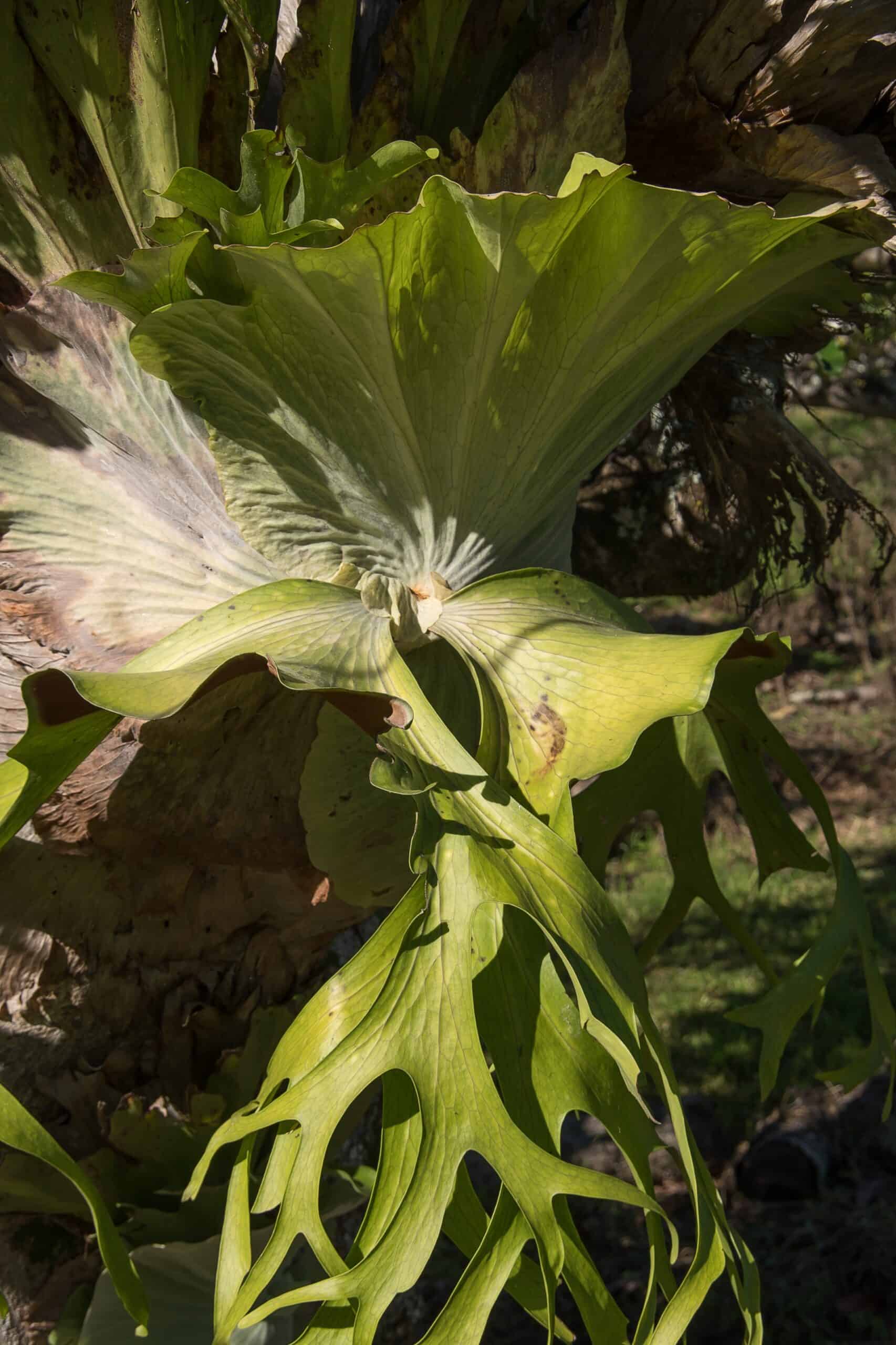Have you seen deer antlers hanging on the wall as a decoration? Oh, deer! Cruel to the animal. What isn’t evil and “vegan,” but a unique decoration piece is staghorn fern.
“Staghorn Fern,” as the name sounds, looks like Staghorn can be mounted to the wall and has a beautiful appearance. But the thing that can ruin its beauty: overwatering.
To save an overwatered Staghorn fern, remove the affected leaves with clean equipment first, dry the plant and the soil, treat root rot. Begin watering again if the plant shows signs of recovery, reduce the frequency to once a month and be careful not to drown the roots or the antler fronds.
Let’s delve deep and find out what symptoms your plant is showing and how to treat them out of overwatering.
Table of Contents
Signs of Overwatered Staghorn Fern
Staghorn ferns don’t require too much water on them as they rely on the support of a wall to grow.
Fern consists of the rootball and two types of fronds: Antler and Shield. Antler fronds are bifurcated, and spores develop at the tip of them.
Shield fronds take up water and nutrients and also protect the roots. They are at the bottom of the plant.
As the plant is an epiphyte, the rootball acts like support and attaches the plant to an object, helping them grow. The number of roots is low in this plant, and thus the damage of roots may cause the plant to wilt.

Overwatering invites various types of other anomalies and damages the natural beauty of the plant.
Your Staghorn Fern will provide various signs of overwatering. Look for the signs and take appropriate measures to revitalize them.
1. Spots and Patches on the Leaves
Spots and Patches on the plant will blemish the plant’s natural green color and make the plant look ugly.
Too much water can uneven the distribution of nutrients on the plant, thus making the spots and patches appear.
2. A Severe Case of Root Rot
Staghorn Fern contains less number of roots as they are epiphytes.
Overwatering the plant may cause the roots to rot and eventually damage the plant. Occasionally, check for root rots, discover the damage and neutralize them in time.

3. Brown/Black spots on the Base of Antler Fronds
Rhizoctonia is a pesky fungus that attacks the basal fronds of the Staghorn fern. They make black spots appear on the shield fronds, slowly spreading on the entire plant, eventually killing the plant.
Another common sign to look for in the plant is black/brown spots on the base of antler fronds. The appearance of these spots is a sign that the plant is being overwatered.
4. Wilting of the Plant
Staghorn ferns live on the walls and look majestic with the firmly standing foliage. Once the overwatering symptoms kick in, the plant seems droopy, and the leaves start to wilt.
If the soil is always damp, there aren’t enough air pockets. Plants are unable to breathe due to a lack of oxygen. As a result, the plant begins to wilt.

5. Mold Growing on the soil
Staghorn ferns love to be mounted rather than planted. Molds/fungus can grow on the soil near the base of this plant as it holds water if not mounted properly.
The mold takes up all the moisture targeted for the plant making the plant suffer gravely.
Here’s how to fix the damage due to mold.
- Move the plant to a new environment. Arrange for a suitable place and remount the plant.
- Place the plant in ample but not too harsh sunlight.
- Use 1:10 organic fertilizer to soil ratio. Make sure you have mixed the fertilizer thoroughly into the soil.
- If you are looking for an easy fix, wipe the mold away with a paper napkin.
6. Invitation to Pests
Although the staghorn fern is not much susceptible to pests damage, overwatering the plant can invite some pests that can cause severe damage to the plant.
Some insects, like springtails, love a surrounding that can fulfill their food and water needs. Insects like mealy bugs, snails, and slugs also attack the plant, although it’s not evident that they need water to flourish.
Powdery mildew is a disease caused by various species in the order Erysiphales. White-grayish powder-like substances appear on the foliage of the plant affected by this.
How to Fix an Overwatered Staghorn Fern?
We can recover the overwatered Staghorn Fern if the foliage and the roots have not sustained severe damage.
Follow the following steps to nurse them back to full health.
Step 1: Dry the Plant and the Soil
When I found out that my plant was showing the symptoms of overwatering, I dried the plant and the soil as the first resort.
I followed these steps, and you should do the same.
- Remove the plant from its spot and dry the soil using newspapers or kitchen towels.
- Increase the amount of light and temperature the plant is getting to let the soil dry quickly.
- Put your hairdryer in a cool setting and dry the soil with it without damaging the soil near the rootball.
- Set your plant on dry soil and replace the soil it was in previously. Fill the pot with dry soil and place the plant after it is dry.
You can go back to your regular watering schedule afterward.

Step 2: Treat Root Rot
Root rot is the natural and most dangerous enemy of indoor plants.
Staghorn Ferns generally support other tree barks in their natural habitats. They have fewer roots for the transportation of nutrients to the plant.
Rotting on the root can severely damage the plant as the plant cannot get things required to thrive.
So, you should inspect the roots properly and treat the plant if you find root rot.
- Take the plant out of the soil and wash away the excess soil on the roots.
- Inspect properly for rot or decay on the root.
- Use a clean pair of garden scissors to cut the root above the brown part. Make sure you don’t accidentally cut or damage the healthy roots.
- Transfer the plant to another pot with a well-drained, porous potting mix of peat moss or shredded pine bark.
- Water the plant, but make sure the new pot has a good drainage system, and excess water is not accumulating.
- Use methyl bromide fumigant to reduce the level of root infection.
Note: If most of the roots look brown and mushy, it is better to discard the plant as a whole as it is beyond saving.
Step 3: Repot or Remount the Plant
If the soil this plant is standing on is not good enough to keep growing, it will be best to move the plant to better conditions.
Staghorn Fern would instead be mounted than potted so keep that in mind whether you want to mount them or pot them.
Steps for Repotting Staghorn Fern
- Prepare a wire basket at least 2 inches larger in diameter than the current pot.
- Fill the basket with a 1-inch layer of sphagnum peat moss tightly.
- Fill half of the basket with potting soil and a few wood chips.
- Take the fern from the original container and plant it in the new pot, exposing the leaves.
- Press down and spread the soil evenly around the basket.

Steps for Remounting the Staghorn Fern
- First, let the roots dry. Treat the infected roots.
- Place a handful of sphagnum moss on top of the board and the plant on top of it.
- Use wire to secure your plant.
Our article “How to Mount a Staghorn Fern” would be helpful.
Watch this for more information on Repotting Staghorn Fern
Tips to Prevent Overwatering in Staghorn Fern
Overwatering can cause severe damage to staghorn fern. You should always check the moisture content in the soil to prevent overwatering.
Look for the following things to prevent overwatering your plants.
- Water once a week during summer when the weather is dry. During winter, water the plant every two to three weeks.
- As the Staghorn Fern is both air plant and fern, you can soak the whole plant in water once or twice a week.
- Mist the plants occasionally as the staghorn ferns absorb water through their fronds. These plants love humid conditions.
- If the humidity in the atmosphere is high, then avoid watering your plant.
- If the base of the antler fronds starts to change their color to brown and similar spots appear on the base, stop watering the plant for some time, as this is the sign of overwatering.
- Heat and light are important factors that should affect your watering schedule. If your plant does not get enough heat and light, you should reduce the watering.

Conclusion
Staghorn Fern is a lovely green plant that can increase the charm of your house if it is in full health. The mighty antler-shaped leaves do not lose their stature if adequately watered.
Follow the above tips to prevent your plant from getting stressed due to overwatering.
Take good care of your decoration!
